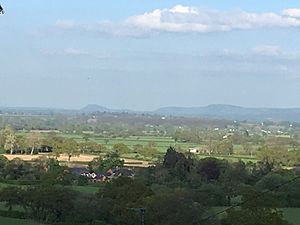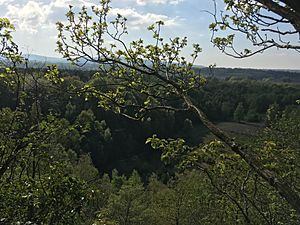The Rofft facts for kids
The Rofft was a very old place located in Marford, a village in the Wrexham County Borough in Wales. It started as an ancient camp built by people long ago. Later, it became a motte and bailey castle. A motte and bailey castle is a simple type of castle with a mound (motte) and a walled yard (bailey). Today, you can't see any signs of The Rofft because it has disappeared over time.
Contents
The Rofft Before 1066
Long before the Normans arrived in England in 1066, The Rofft was an Iron Age fort. This was like a large, walled camp built by people living in the Iron Age. It covered about 30 acres, which is a very big area! The fort was built on a flat-topped hill. This was a smart choice because it gave people great views towards a place called Pulford.
Old Welsh writings from the 600s say that Pulford was the border between Wales and a kingdom called Mercia. The Rofft fort, along with other small forts nearby, helped protect the way to the River Alyn valley. The Rofft fort was also important for the local area of Marford. It was a place where local rules were made and problems were solved for the community.
The Rofft After the Normans Arrived
In 1071, William I gave a large area, including modern-day Marford, to a powerful lord named Hugh d'Avranches. The Domesday Book, a famous survey from 1086, shows that another Norman lord, Osbern Fitz Tesso, controlled Marford and Hoseley.
Historians believe the Normans built the motte and bailey castle at The Rofft. They wanted to spread their power further into this part of Wales. The castle's bailey (the walled yard) was built about 18 feet higher than the ground around it. It was also protected by a dry moat, which was a ditch without water.
Old records about the castle are not very clear. Some say the castle was badly damaged in March 1140. They also say it was rebuilt by a Welsh prince named Madog ap Maredudd. However, it's not certain if this record is about The Rofft Castle or another castle in Wrexham. If it's not about The Rofft, then the first clear mention of The Rofft in writing is from 1161–62.
The castle was also involved in collecting tolls (payments) at a nearby place called Pant Olwen. The Rofft castle also had an impact on the local area. It controlled a medieval park called Mersley Park. The only nearby church, St. Leonards chapel, was also under the castle's control.
Why The Rofft Became Less Important
Over time, The Rofft castle became less important. This happened for a few reasons.
- Newer Castles: Stronger stone castles, like Dinas Bran near Llangollen, were built. These new castles made the older motte and bailey castles, like The Rofft, less significant.
- Wrexham's Growth: The town of Wrexham grew and became the main center for trade and business in the area.
- Political Changes: In 1282, the areas of Marford, Wrexham, and Yale were joined together. They formed a new, larger area called the Lordship of Bromfield and Yale. The important royal officials who used to live at The Rofft moved to Wrexham. When William de Warenne took control of Bromfield in 1284, he chose Wrexham as the place to do it, not The Rofft.
- New Churches: In the mid-1200s, a new church called All Saints' Church, Gresford was built. This made the Chapel of St. Leonard, which was connected to The Rofft, less important.
What Happened to The Rofft After the 1300s
A survey in 1315 mentioned a manor house (a large country house) on the site of The Rofft's bailey. By 1575, a building called Rofft Hall stood where the old Iron Age fort used to be.
In the 1840s, a railway was built. This construction partly destroyed the old earthworks (mounds and ditches) of The Rofft. Then, between 1927 and 1958, the entire site of The Rofft was completely destroyed by gravel quarrying. This means people dug up the land to get gravel.
Today, The Rofft only exists in names. Some land nearby is still called Castle Croft. Also, the local school, The Rofft Primary School in Marford, is named after the old site.
Mersley Park, which was once controlled by The Rofft, later became known as Holt Park. It was eventually closed down in the 1600s. You can still find traces of the park in local place names like Parkside and Lower Park. The Chapel of St. Leonard stood until the 1400s. No one knows exactly where the chapel was, but a road called Pont-Y-Capel remembers its name.



